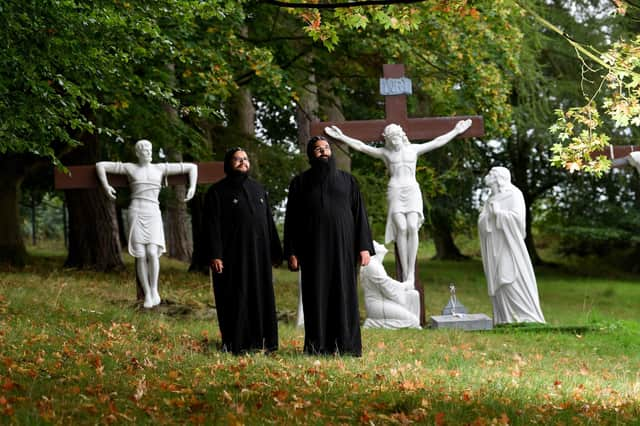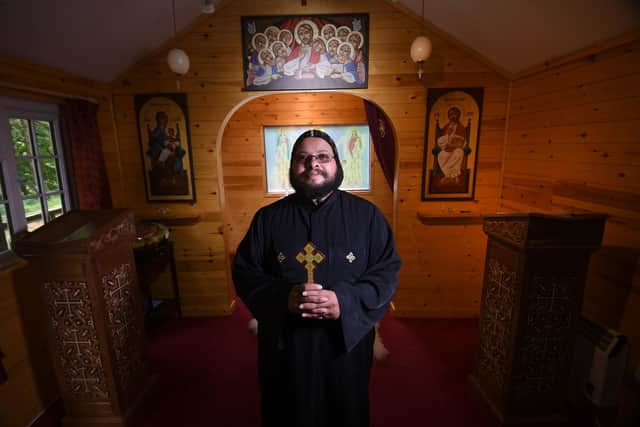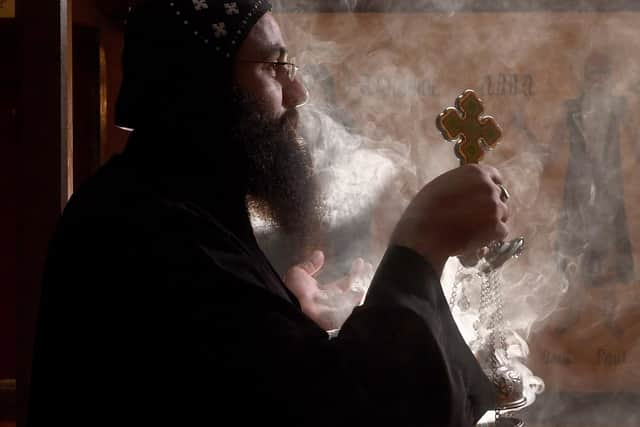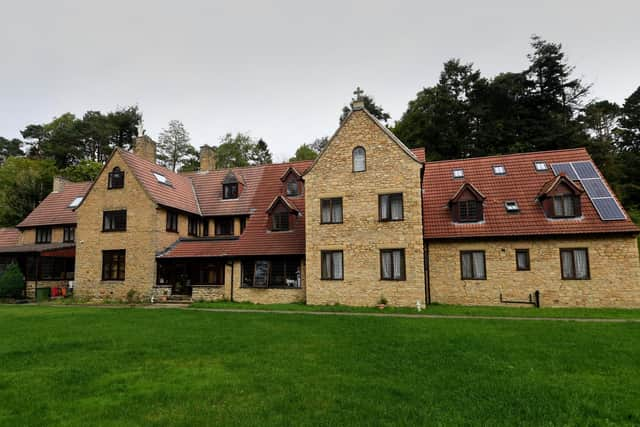A Scarborough house is UK's first Coptic monastery and home to nine Egyptian monks


They are representatives of the Coptic Orthodox Church, an Egyptian Christian denomination which traces its origins back to the first century AD.
The Copts, an ethnic and religious minority in Egypt, can claim direct descent from their ancient ancestors of pyramid-building fame. Their church is headquartered in Alexandria in the Nile Delta, and yet, since 2004, the monks of St Athanasius’ have called this part of the world their home.
Advertisement
Hide AdAdvertisement
Hide AdThe only roads to St Athanasius’ are narrow and twisting, and there’s no phone reception. You only realise you have arrived when you see a painting of Jesus on the side of a barn. A converted 17th century manor house, which serves as the main monastery building, sits at the centre of a 102-acre property, which is also home to a small chapel, cottages for visitors, and about eight hundred sheep.


The path to the chapel, where I am joining some of the monks for their 9am Mass, is lined with life-size Stations of the Cross, a sequence of statues depicting the day of Jesus’ crucifixion. Although they have churches in some of the big cities, this is the Copts’ only monastery in the UK.
The Mass – which lasts a whole two hours – is celebrated in a mixture of Coptic (a variant of the ancient Egyptian language once spoken by the Pharaohs), English, Arabic, and ancient Greek. The monks are constantly in motion, turning in circles around the altar, moving back and forth from the lectern to read from the Bible, spinning incense burners above their heads, dropping to their knees to prostrate themselves; at times it looks as though they’re dancing. When one of them gives a sermon, the other monks sit cross-legged on the carpet to listen to him. Almost all the prayers and readings are chanted, rather than spoken, with a simple, searching melody that stays in my head for the rest of the day.
After Mass, on a normal day, the monks have breakfast together, before heading out into the fields at about midday for work.
Advertisement
Hide AdAdvertisement
Hide AdThey return at around four or five in the afternoon, and have a prayer service at six, followed by dinner, and then a sung prayer service from eleven at night to one in the morning. In between, they find time to pray, and to read the Bible and texts written by desert-dwelling Egyptian monks in the first few centuries of Christianity. Some of them then have to wake up early to bake the bread which will be used for Communion in that day’s Mass.


My guide, Fr Yostos, is a middle-aged man, with a welcoming smile and booming laugh, he wears, like all Coptic monks, a long black robe, a black skullcap adorned with thirteen white crosses, and a thick beard.
St Athanasius’ is home to him and eight of his fellow monks, all but one – a Brit of Egyptian descent – born in Egypt. Before joining the monastery, they held a variety of jobs: accountant, physics teacher, pharmacist, physician, engineer.
As well as the sheep, they have more than a thousand lambs, and five cows. It’s about self-sufficiency, he tells me.
Advertisement
Hide AdAdvertisement
Hide AdThe monks are not allowed to work in the world outside, and so they raise livestock for food, and to sell to local butchers for money, which they then spend on essentials they cannot produce themselves.


None of them had any experience in agriculture before they arrived at the monastery, and so they learnt on the job, by consulting the local vet, enrolling in farming courses, and even watching YouTube videos.
In Egypt, another monk, Fr Arsenius, says, monasteries are built in the desert, and so have much more land, which they often use to build workshops and factories, producing everything from wooden furnishings to electronics cables. Often visitors to monasteries in Egypt will volunteer to help with the work while they stay.
“Here,” Fr Arsenius jokes,”everyone is much more busy, so if we want labourers we have to pay them, and then we have no profits left.”
Advertisement
Hide AdAdvertisement
Hide AdDespite the higher costs of land and labour in the UK, the monastery has been in a state of almost permanent expansion since it was founded.
To begin with, the local Coptic bishop – who has responsibility for all of North-East England, Scotland, and Ireland – bought the land around the original site, which initially comprised only 23 acres, in order to allow St Athanasius’ to increase the size of its herd.
The central building – a manor house built by the Rowntree family of York, although recently it had served as a B&B – was then doubled in size, an expansion which has preserved the original character of the building so well it is virtually impossible to tell until it is pointed out.
Work, moreover, is already under way on the monks’ most ambitious project yet, the construction of a two-storey church built in the Egyptian style, complete with two domed spires.
Advertisement
Hide AdAdvertisement
Hide AdThe parish council had complained that the building would be out of keeping with the local landscape, but park authorities found in the monks’ favour, pointing out that the area is heir to a long monastic tradition; the historic abbeys of Rievaulx, Byland and Fountains are all close at hand.
After we visit the larger of the monastery’s two current churches – which is beautifully painted, but a good bit smaller than the average school classroom – you can understand the need for a new one.
Sunday Mass here regularly attracts up to 40 worshippers, and some feast days see as many as 150 attend. At present, they have to gather in the rooms adjacent to the church, and follow along by means of a speaker system.
Many of these visitors to the monastery are of Egyptian descent.
Advertisement
Hide AdAdvertisement
Hide AdThe Coptic Church has deep roots in Egypt, something the monks place great emphasis on. Fr Yostos proudly explains that the prayers recited in the Coptic language during the Mass have not changed in 1,700 years.
He makes frequent reference to the Copts killed for their faith in a part of the world that has not always been hospitable to it – the thousands massacred by the Roman Emperor Diocletian in the 4th century, for example, and the twenty beheaded by Islamic State terrorists in one day in 2015.
As he stresses, however, while the Coptic Church is historically Egyptian, it is entirely universal in outlook; its job is not to serve Egyptians, Fr Yostos says, but to serve the entire world.
Given the long history of their church, and its connection to the very first centuries of Christianity, the monks of St Athanasius’ Monastery believe that they have something to offer everyone, whether they live in the shadow of the Great Pyramids or here in the moors and vales of God’s own country.